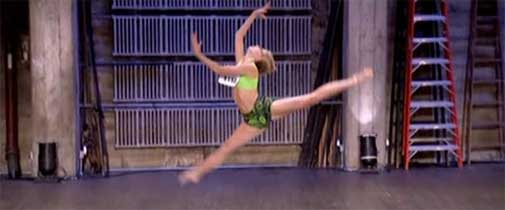
[TVWW contributor Theresa Corigliano, who has a dance background as part of her very full resume, attended the Los Angeles auditions of Fox's So You Think You Can Dance, which returns for season eight tonight at 8 ET. "The good ones make it look easy," she writes. "My admiration comes from the muscle memory that it is not..." -- DB]
By Theresa Corigliano
I think of myself as a dancer.
Yes, my glory years were between the ages of 6 and 13, at Mrs. Thompson's Dance School on Long Island, and later as an adult, when I took classes with some very competitive ladies studying with former Broadway and film star Florence Lessing.
Miss Lessing let me take pointe then (a nerve-wracking audition, but I wasn't kidding myself that my talent was trumped by my ability to pay the tuition). And yes, I did make it to her advanced class, which would sometimes include budding stars from the New York City Ballet and American Ballet Theater. But that was a long time and a few torn ligaments ago.
Yet it seems like yesterday. There is a concept in dance called muscle memory. If you mark the steps -- that is, walk through them, counting with the music, rather than dancing full out, the body remembers. This is why I can dance the exact same recital steps from a can-can I did when I was seven (step brush brush, step brush brush step, clap-clap), and why my arms automatically form a graceful port de bras in sync with the exercises at the barre, even though the last class I took was a hundred years ago.
It is also why I feel myself choke up as I watch So You Think You Can Dance contestants audition for Season 8 on a March too-chilly-to-be-spring weekend in Los Angeles. The good ones make it look easy. My admiration comes from the muscle memory that it is not...
--
If you haven't seen this show because you liken it to ABC's Dancing with the Stars, the two are nothing alike. While the celebrities on DWTS do work hard and some eventually perform on an impressive level for non-dancers, SYTYCD is much more serious competition.

The show has been nominated for 14 Emmys and won seven. Not bad for a show concept that even Nigel Lythgoe doubted.
"I'm going to have to tell the truth on this one," the co-creator and executive producer said with a broad smile when asked if he was prescient enough to think a dance show could survive on television. "I never thought it would work."
"It came from Simon Fuller, who created American Idol, and he said, if we've done this for singers, you in particular since you had a career as a dancer, should be able to do it for dancers. I said it wouldn't work, it's not the same, no one watches [dance], and there's nowhere for the dancers to go at the end of it.
"We went away for the weekend to Cabo. Simon sent me down the garden with a bottle of Jack Daniels, I came back with half a bottle of JD and a format for SYTYCD. [I was nervous] until we did the first few auditions, and then I was really excited and thought, no, this is really entertaining, this can work."
For the past eight seasons, exceptionally talented dancers in all disciplines have competed to become America's favorite dancer -- a title with some notoriety that, in reality, means they might be able actually earn a living doing what they love.
There are no mirror ball trophies in sight, but the winner does collect $250,000, and the top dancers get to go on tour, much like the singers on American Idol. Some then will go on to work in film, television (SYTYCD contestants have appeared on Glee and, ironically, Dancing with the Stars), on Broadway, on tour, in videos, or regional companies.
Dancers dance, and they don't do it to get famous. It's unlikely, save for fans of the show, that the general public will ever know their names. They do it because they must.
There will be some format changes this year. Judge Adam Shankman is off making the film version of Rock of Ages, but may make guest shots, schedule permitting. Lythgoe and Mary Murphy will be the two permanent judges, and the third seat will rotate. Lythgoe intends to fill it occasionally with non-dancer/choreographers -- people like Will.I.Am, who have a real sense of dance and music.
"I want to use the revolving judge chair to bring in different points of view," he said, "so we are talking about performances, we're not just talking about how the arched foot is terrific."
Last season, only 10 finalists were chosen, not 20, and instead of dancing with each other, they were paired with all-stars from previous seasons. This year, Lythgoe says he will pair the dancers together for first five weeks, at which point the all-stars will join in.
"Last year we had Top 10," Lythgoe said, "but a lot of people didn't buy that, they wanted to see the relationship between amateurs. My feeling was that putting them with all-stars lifted their game immensely and lifted their confidence, and also lifted the choreographers. What I wanted to do this year is to try and please everybody. Let's see if we can."
AT THE LOS ANGELES AUDITIONS: SATURDAY
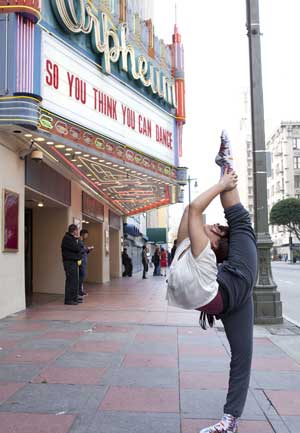
A little after dawn, dancer hopefuls who think they are worthy of making the Top 20 have shown up to prove it. The scraggly line takes up three city blocks outside the landmark Orpheum Theater. The first person in the queue arrived on these dodgy downtown streets at 11 p.m. the night before the audition.
Lucy Dorado had come straight from a flight that left Hawaii, just ahead of the tsunami warnings, with chair, food, clothing and a sleeping bag. She waited alone on the sidewalk for a good part of the night, with most of the dancers arriving at around 4:30 am the next day. But when I asked Lucy what style of dance she performed she said: "I actually don't dance and I'm not competing. I'm holding this place for my brother."
She didn't want brother Ben's muscles to lock up in the cold night air. She wanted him to get some sleep. She brushed off questions about why she would do it. "This is my brother's dream. He would do it for me." Her brother, a classmate of last season's injured star Alex Wong, dances contemporary ballet, and he said he has performed with the American Ballet Theater, San Francisco Ballet. These are not small credits.
Kevin Ahearn stands behind the Dorados. He arrived a little after Lucy did, and this hip-hop, jazz funk specialist from Sonoma County makes a living coaching all-star cheerleading at a gym in Pasadena. The implausibility of making a career out of that, Ahearn says, makes his dad laugh.
Miranda Hayworth Curry, a contemporary ballet dancer, auditioned last season wearing one pointe shoe. I have no idea why, and neither did Nigel (supposedly it helped her grip the floor, which was a slippery ballroom dance floor) but this year, she'll wear the pair. She has a 3-year-old son, for whom she put her career on hold, but now she is back and she is here, midway down the line.
Twenty-year-old jazz dancer Melanie Tresson wants to be a Rockette like her grandmother, who danced with the famed Radio City Hall troupe from 1939-1942. She's auditioned twice for the renowned kick line.
"I'm just tall enough," she laughs. "I'll just make it, even though [if I do] I will be at end of line."
The person on the end of today's line, down the street and around the corner, is 29-year-old ballroom dancer Ivy. The age restriction tops out at 30, so she and Miranda Curry have that in common -- this is their last shot, at least as far as SYTYCD is concerned. Ivy has been teaching at Arthur Murray Studios for 8 years, but she had decided today to dance contemporary ballet because, she tells me, bright smile slipping only slightly, she was unable to convince anyone to partner her.
Nearby, Nao and Jon, originally from Florida but now living in LA, are rehearsing. They are street dancers and cousins who pop and lock and study martial arts. They are also best friends with the charming B boy Jose from last season. Both of them had made it to Vegas before, but were done in by the choreography.
(The way it works on SYTYCD is that if you're good to face the judges, you either go straight through to the competition rounds in Vegas, or if the judges need further convincing, it's on to choreography first, where the final evaluation is made and you either get that coveted airline ticket, or you don't.)
This time, because they took dance classes, Nao and John know they will be better. When I ask them if they think their relationship with such a popular contestant as Jose will help, they shake their heads, though they admit anything that might distinguish them in front of the judges can't be a bad thing.
"I don't think it will make a difference," Jon said firmly. There are so any talented dancers, they're just going to say, 'Let's see what they can do.'" He added: "You've got to land the plane."
It is now 6:30 am, and SYTYCD cameramen are shooting the crowd for the Los Angeles audition show open. The closer the cameras get, the more animated the dancers become. They may be young, but they know how to get face time. By the time Cat Deeley, the charming and sociable Brit who hosts the show, comes out the front door of the theater to work the line, it is closer to 10 am, but the line tingles with anticipation. You can almost hear them thinking: Will she notice me so I might be included in the show's opening footage? What can I do to make her notice me?
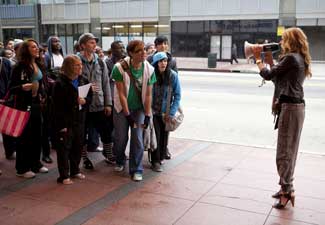
Deeley, carelessly chic in cropped pants, a short leather jacket, and a scarf knotted artfully around her neck, crouches to embrace the first person she sees, a small child, perhaps a family member, who isn't a dancer. The tall blonde with a broad smile radiates a warmth so genuine, she makes those lined up for hours forget how chilly it is.
She grabs the hat from a Michael Jackson wannabe and claps it on her head, trying to learn his moves. She drops to the filthy, cold sidewalk to swap out her stilettos for another auditioner's tap shoes, and gamely tries to move in tandem with him, verifying what she has claimed as a complete inability to dance. She sees Superman behind another contestant's Clark Kent glasses, and he is more than happy to do a back flip for her. The dancer with the alarm red hair shares his scarlet balloon. Then, after a quick touchup from a watchful hair and makeup team, a few sips of coffee from a takeaway cup, and some laughing exchanges with various producers and crew, she positions herself at the head of the line, megaphone in hand, ready to exhort contestants into the theater. They get it done in one take.
Standing nearby, SYTYCD co-executive producer Jeff Thacker, who has been with the show from the beginning, admitted he was amazed that a proffer for three months of work from fellow Brits Lythgoe and Simon Fuller has turned into eight seasons.
"No one knew who we were in season one," he said. I like to say we never did the same show once. The show just grew and grew."
Thacker sees the critiques the judges offer as constructive not destructive. "You have to be honest. Most dancers like to be critiqued. When I was a choreographer, dancers used to say: 'You keep giving me notes.' I'd say, be happy, that means I'm looking at you."
And that's exactly what he will be doing over the next several hours. Thacker is the first hurdle in the audition process. He will cull through the contestants, choosing those good enough (with a sprinkling of crazies for comic relief, sort of like the tone-deaf singers who audition for Idol) to go before uber judges Lythgoe; instructor and ballroom expert Mary Murphy, who returns to the show after beating thyroid cancer and with a contract that apparently made her happier than the last one that was offered, leading to her departure for one season; and Emmy award-winning choreographer, Broadway and film dancing star Tyce Diorio.
Finally, after their long wait -- warming up on the sidewalks, marking their routines over and over again, sizing up the competition -- the contestants are allowed inside the Orpheum for real, not just for the cameras. The media, unfortunately, are not.
SUNDAY
It is the first day of callbacks. In the house, along with vocal family members and supporters, are nervous dancers, identifying numbers pasted on their torsos. These are the lucky ones who made it past Thacker the day before. In all, 320 contestants have made it through to the next round, the second highest number of dancers from any other city other than Atlanta.
They take the stage in groups, lining up on either side of the Orpheum stage. The same Black Eyed Peas snippet of music is played for each of the solo auditions. "Change! And change!" Lythgoe commands the dancers on the sidelines to move front and center for their moment.
As they fling themselves into the air and land as soundlessly as birds on a telephone wire, I swallow the lump in my throat. Their faces light up as they take turns improvising, twirling or flipping or locking or tapping. Some know how to play to the judges; others fight for their moment. Some pop; some with beautiful bodies have no spark, and the sore thumbs stick out.
Lythgoe chides one dancer for not listening to his instructions. "If you don't make it today, you'll know why." The savvier dancers are wearing distinctive outfits. One young man performs in boots and suspenders. Sometimes it works; sometimes it is style over substance.
After they dance, the groups are asked to form two lines by their numbers. "Step forward," Lythgoe says. Sometimes the front line stays, sometimes, it goes. Psych! Most of the time, I find myself agreeing with the judges' decisions, and sometimes, I wonder what they see that I don't.
--
Those lucky enough to pass this test then audition for the judges using their own music, and will soon know whether or not they will be dancing out of obscurity into the chance of a career. One by one, they step up to the mic (no one, of course, seems to know you don't have to hunch over it for your voice to be amplified, but neither do most of the winners on Oscar night) and introduce themselves.
They all want to distinguish themselves. Some offer willingly. Others have to be drawn out. When one boy admits to a falling out with his mother, Lythgoe tells him, very seriously: "Fix it or you'll regret it for the rest of your life." Even though the judges are looking for stories, Lythgoe insists: "I'm not one of those who thinks backstories should dominate. The talent of the person comes first and foremost. If they have a great backstory that that just gives them extra points in the process."
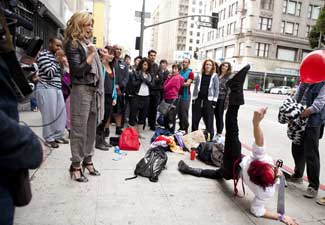
Over the course of the morning, the judges note lack of personality, not performance. To the untrained street dancers, Lythgoe cautions those hoping to make it to Vegas: "You really have to wow us." (In a later interview, he says a lot of the street dancers have gotten through, which pleases him.
"If we stick rigidly with technique, then it can become a little boring, because then all we can say is you were fantastic. I love the danger of the kid who dives onto the back of his head. He doesn't know if he's going to break his neck. That's what gets my heart pounding.")
Mary Murphy notes one hopeful's intricate moves, but adds: "If you can't sell it, people aren't going to pick up the telephone for you." A krumper dressed like Santa Claus who says he's from Pasadena but originally hails from the North Pole, is entertaining until he rips his shirt off, displaying a less than toned body. After he leaves the stage with no ticket to Vegas, Mary guesses he will be one of the crazies who makes it onto the broadcast.
"We're going to horrify a lot of children out there," she says.
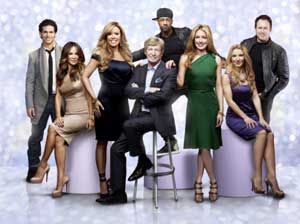
All of the judges are respectful, but they are also direct, and none more so than Diorio, more Simon than Ellen in his assessments. He tells one street dancer: "It's what I've seen before, and others have done it better." He calls another dancer "generic," and adds: "Dance is life, and if you're not living a life up there [on the stage], then it's not going to wake anybody up."
During a break, I ask him about the documentary Every Little Step, which chronicled the casting of A Chorus Line's Broadway revival, zeroing in on the very young, talented, outspoken, egotistical and driven Diorio, who did not get the part he wanted.
"Is that person with you as you critique these dancers?" I ask. He seems nonplussed by the question at first. "It's an amazing documentary and I wouldn't change anything I said in it or did. I have stood in their shoes and I know and I understand them."
I ask if, sometimes, the hardest note to take for a dancer can also be the best one he's ever received. Thoughtfully, he recalls what was said to him during the Chorus Line auditions.
"They said: 'We really feel like you think this is the Tyce Dirorio show. We're sensing a lot of ego.' How do I respond to that? I said I can't apologize for my talent. They were considering me to be the understudy. That is their right to see me how they see me, no disrespect, but I know I'm not an understudy.
"I said in the movie I do see bigger things for myself, I see myself walking up the stair winning an Emmy, and I won it a year later. I could have listened and been an understudy or won the Emmy."
He adds: "It's like the Jennifer Hudson story... They told her she wasn't that good. Well, she certainly showed them. It doesn't make it right, it's just their opinion. It doesn't shape your future. You have to know where you're going. You have stay open, it is what it is for that moment and that's it. I am looking for dancers who have that inner confidence and knowledge. It may not be right for this show, but it is so amazing to see that.
"Who knows where you are going to land? One door closes, another one opens. It doesn't shape your future. You can't buy into that."
--
Later in the afternoon, the auditions continue, but the media sitting in the audience are told -- very firmly -- it is time for us to leave. I don't want to leave. I could sit there all day, and for the next two days that they are going to be there, but I have no choice. I have not yet seen any of the hopefuls I spoke to on line. I have no idea if they made it past Jeff Thacker, and if they will be appearing before the judges until SYTYCD comes back on the air.
I will be watching, though. And if they don't make it, I will be remembering what Diorio said, and hope these dancers keep dancing, no matter what they have been told.